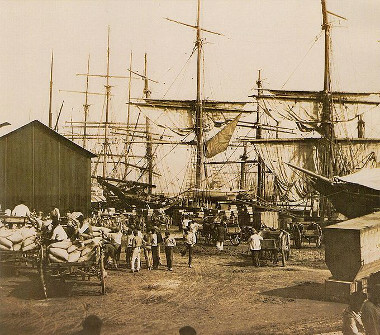Coffee was the main export product of the Brazilian economy during the 19th century and the beginning of the 20th century, guaranteeing the necessary currency to sustain the Empire of Brazil and also the Republic Old.
The roots of coffee in Brazil were planted in the 18th century, when the plant's seedlings were cultivated for the first time, which is known by Francisco de Melo Palheta, in 1727, in Pará. From then on, coffee spread timidly along the Brazilian coast, heading south, until it reached the region of Rio de Janeiro, around 1760.
However, its production on a commercial scale for export only gained strength in the beginning of the 19th century. This dimension of coffee production was only possible with the increase in demand for the product by consumer markets in Europe and the USA.
The consumption of coffee on the European continent and in North America occurred after the plant travels, since Antiquity, a journey that took her from the African Ethiopian plains to the tables and cups of the industrialized countries of the century XIX. But this required an expansion of its consumption by the Arab Empire and the Islamic world, being later presented to Europeans, who made their consumption more expressive around the century XVII.
Coffee production in Brazil expanded from the Baixada Fluminense and the Paraíba river valley, which crossed the provinces of Rio de Janeiro and São Paulo. Coffee growing in Brazil benefited from the country's slave structure, being incorporated into the system plantation, basically characterized by export-oriented monoculture, slave labor and cultivation on large estates.
In this region of Brazil, coffee production benefited from the climate and soil conducive to its development. The fact that it is a goods transport route between Rio de Janeiro and the mining zones also contributed to the adoption of coffee plantations, as part of the land was deforested, initially facilitating the introduction of coffee plantations and benefiting the flow of production through roads existing.
The initial capital for the production of coffee came from the farmers and traders themselves, mainly those who managed to accumulate capital with the economic impulse verified after the arrival of the Royal Family in Brazil, from 1808.
Coffee production techniques were simple. Initially, land was deforested where it was necessary to expand the arable areas for the placement of plant seedlings. These took about five years to start producing. At that time, other crops were planted around the coffee plantations, mainly foodstuffs. For the conservation of the plants, only hoes and sickles were needed. The harvest was done manually by the slaves, who, after this task, put the coffee beans to dry in terraces. Once dry, the coffee was processed, removing the materials that coated the grain through mojolos, primitive wooden machines formed by punching pestles powered by water.
After this process, the coffee was transported on the backs of mules to the port of Rio de Janeiro, from where it was exported. But the increase in coffee production and the resulting profits led to the beginning of the process of modernization of the Brazilian economy and society.
One of the most striking examples of this modernization was the construction of railroads for the transport of coffee, which increased the speed of transport and interconnected some regions of the Empire, especially after the expansion of crops to the purple lands located in the so-called West of São Paulo, intensified after the decade of 1860. This situation also led to the strengthening of the Port of Santos as the main production outlet.

Coffee shipment at the Port of Santos, in an 1880 photograph by Marc Ferrez (1843-1923)
In 1836 and 1837, coffee production surpassed sugar production, making coffee the main export product of the Empire. The large coffee-producing landowners, the so-called “Coffee Barons”, became rich and guaranteed an increase in revenue from the imperial state.
There were also the so-called coffee commissioners, men who acted as intermediaries between landowners and exporters. In addition to controlling the sale of the product, they guaranteed landowners access to credit for expanding production and also made it possible to purchase imported products.
Coffee was, therefore, one of the main pillars of Brazilian society in the 19th and early 20th centuries. It guaranteed the accumulation of capital for the urbanization of some locations in Brazil, such as Rio de Janeiro, São Paulo and cities in the interior of São Paulo, in addition to initially providing the necessary capital for the country's industrialization process and creating the conditions for the development of the system Bank officer.
By Me. Tales Santos
Source: Brazil School - https://brasilescola.uol.com.br/historia/o-cafe-no-brasil-suas-origens.htm
